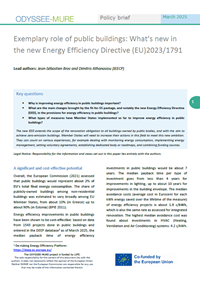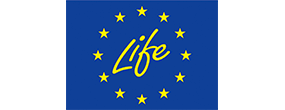Summary
Key questions
- Why is improving energy efficiency in public buildings important?
- What are the main changes brought by the fit-for-55 package, and notably the new Energy Efficiency Directive (EED), in the provisions for energy efficiency in public buildings?
- What types of measures have Member States implemented so far to improve energy efficiency in public buildings?
Lead authors: Jean-Sébastien Broc and Dimitris Athanasiou (IEECP)
The new EED extends the scope of the renovation obligation to all buildings owned by public bodies, and with the aim to achieve zero-emission buildings. Member States will need to increase their actions in this field to meet this new ambition. They can count on various experiences, for example dealing with monitoring energy consumption, implementing energy management, setting voluntary agreements, establishing dedicated body or roadmaps, and combining funding sources.
A significant and cost-effective potential
Overall, the European Commission (2021) assessed that public buildings would represent about 2% of EU’s total final energy consumption. The share of publicly-owned buildings among non-residential buildings was estimated to vary broadly among EU Member States, from about 10% (in Greece) up to about 90% (in Estonia) (BPIE 2011).
Energy efficiency improvements in public buildings have been shown to be cost-effective: based on data from 1543 projects done in public buildings and entered in the DEEP database1 as of March 2025, the median payback time of energy efficiency investments in public buildings would be about 7 years. The median payback time per type of investment goes from less than 4 years for improvements in lighting, up to about 10 years for improvements in the building envelope. The median avoidance costs (average cost in Eurocent for each kWh energy saved over the lifetime of the measure) of energy efficiency projects is about 1.9 c/kWh, which is also the same rate as assessed for integrated renovation. The highest median avoidance cost was found about investments in HVAC (Heating, Ventilation and Air Conditioning) systems: 4.2 c/kWh.
An exemplary role enforced with a specific renovation obligation strengthened in the new Energy Efficiency Directive
The first Energy Efficiency Directive (2012/27/EU) introduced, in its Article 5, an obligation for Member States to renovate 3% per year of the total floor area of central government buildings larger than 250 m² and not yet meeting minimum energy performance requirements. Member States could choose to implement an alternative approach delivering an equivalent amount of energy savings in buildings (e.g. with energy management and behavioural measures). Central government buildings would represent about 10% of all public buildings. The 2012 EED then required Member States to encourage the other public bodies, especially at regional and local level as well as social housing bodies, to adopt an energy efficiency plan, implement an energy management system, and where appropriate use energy services for energy efficiency improvements.
The new Energy Efficiency Directive (EU)2023/1791 has strengthened these provisions, now in Article 6: (1) the scope of the 3%/year renovation obligation is extended to all buildings larger than 250 m² and owned by a public body; and (2) the required depth of renovation is clarified and should achieve at least nearly zero-energy buildings or zero-emission buildings. The related energy savings potential was assessed by the European Commission (2021) to be about 2.6 Mtoe/year by 2030.
Member States may still use an alternative approach to deliver an equivalent amount of energy savings. In addition to monitoring the energy savings achieved, the use of an alternative approach now also requires introducing a renovation passport for buildings representing at least 3 % of the total floor area of buildings owned by public bodies, with the aim to renovate them to nearly-zero energy buildings by 2040.
Renovating public buildings contribute to broader energy efficiency objectives
The obligation for renovating public buildings is expected to be one of the key measures to achieve the umbrella energy efficiency target for the public sector set in Article 5 of the new Energy Efficiency Directive (EED): reducing total final energy consumption of all public bodies by at least 1,9 % each year (vs. 2021 level).
Renovating public buildings can also contribute to the achievement of Member States’ energy savings obligation (now Article 8 in the new EED).
It is also related to provisions of the new Energy Performance of Buildings Directive (EPBD, (EU)2024/1275). The new EPBD (Article 3) has replaced the former long-term renovation strategies (LTRS) with national building renovation plans (NPRB), with the objective to transform existing buildings into zero-emission buildings by 2050. These plans shall address public buildings, as a specific segment of the building stock. Moreover, Article 9 of the new EPBD requires Member States to establish minimum energy performance standards for non-residential buildings (which includes public buildings).
The new EPBD includes provisions stressing the exemplary role of public buildings:
- New buildings shall be zero-emission buildings from January 2028 (vs. January 2030 for all new buildings) (Article 7)
- Buildings owned or occupied by public bodies must issue an Energy Performance Certificate (displayed in a prominent place clearly visible to the public) (Articles 20 and 21)
- Existing public buildings to install solar energy, with a progressive approach that starts in December 2027 for the largest public buildings (2.000 m²) and progressively reduces the threshold until December 2030 (250 m²), while for other buildings this is required in case of major renovation or works on the roof (Article 10).
The Renewable Energy Directive (Article 15a(4)) also refers to the exemplary role of public buildings, related to the share of renewable energy they use.
National, regional and local level fulfil an exemplary role as regards the share of renewable energy used. Member States may allow that the renovation obligation set in the EED be fulfilled by, inter alia, providing for the roofs of public or mixed private-public buildings to be used by third parties for installations that produce energy from renewable sources.
Stronger action needed to meet the higher ambition
During the period 2014-2020, Member States had to report annually to their achievements related to the EED, including about the renovation obligation for central government buildings. Most Member States that chose the alternative approach met their obligation, vs. only half of these that chose the main approach (European Commission, 2022).
For the period 2021-2030, the reporting is now included in the National Energy and Climate Progress Reports, due every two years.
The assessment of the 2023 reporting stressed that “Member States will have to step up their efforts as early as possible in the next years of the obligation period to be able to meet the savings requirement for the whole obligation period ending in 2030” (European Commission, 2023).
The 2023 reporting included few data on energy use in public buildings. When reported, data showed an increase in public buildings’ final energy consumption in 2021 vs. 2020 in three countries (Denmark, Greece and Hungary), and a decrease in two countries (Croatia and Ireland).
The 2023 reporting and assessment were still about the provisions as set in the EED2012. The challenge is now even bigger, when aiming at improving all public buildings to achieve zero-emission buildings.
Overview of energy efficiency measures for public buildings
A review of the measures in the MURE database as of February 2024 found that out of the 383 on-going measures in the services sector, 226 were dealing with public buildings2, including 94 measures specific to public buildings. Four main categories of measures could be identified and are further discussed below.
1) Monitoring and energy management
This is often a first step to improve energy efficiency in buildings. Examples of measures include the deployment or network of energy managers (implemented in Belgium, Croatia, Greece, Malta and Portugal), or requiring public bodies to implement energy management (see table below).
Table 1: Examples of measures specifically about energy management in public buildings
| Country | MURE code | Feature |
| Bulgaria | SER-BG1398 | Mandatory for buildings > 250 m² |
| Croatia | SER-HR3956 | National information system |
| Hungary | SER-HU1623 | Mandatory action plans |
| Latvia | SER-LV1712 | Local authorities |
| SER-LV1710 | Central government | |
| Slovenia | SER-SI1869 | Mandatory for buildings > 250 m² |
Good practices include:
- Croatia’s energy management information system3, started in 2014, that includes an automation of data collection, an integration with other databases, training of energy managers, the verification of actual energy savings, and the possibility to expand its use beyond the public sector.
- Ireland’s monitoring & reporting4, started in 2013, requiring public bodies and schools to report energy performance annually to an information system operated by SEAI, tracking national target achievement, providing public bodies with feedback and benchmarking, and showcasing results to the general public.
Monitoring and energy management is also often a key component in voluntary agreements.
2) Agreements or obligations
Agreements or obligations can take various forms, and cover different scope (from specific segments to the whole non-residential buildings).
Table 2: Examples of agreements or voluntary commitments
| Country | MURE code | Name of the measure |
| Finland | SER-FI1509 | Energy Efficiency Agreement for Municipalities |
| SER-FI1514 | Energy Efficiency Agreement of the Property and Building Sector | |
| France | SER-FR1553 | Label for municipalities committing to target and action plan |
| Latvia | SER-LV5083 | Energy Efficiency Agreement for Municipalities |
Table 3: Examples of obligations or mandatory targets for all tertiary buildings
| Country | MURE code | Name of the measure |
| Belgium | SER-BE1378 | Brussels - PLAGE (mandatory plan and target for major consumers) |
| France | SER-FR4451 | Tertiary decree' (mandatory reporting and target for all tertiary buildings) |
| Netherlands | SER-NL1765 | Minimum energy performance (C-label) for offices |
Table 4: Examples of obligations or mandatory targets for public buildings
| Country | MURE code | Name of the measure |
| Bulgaria | SER-BG1407 | Mandatory Energy Efficiency Programmes for central government and local authorities |
| Cyprus | SER-CY3978 | Annual energy savings obligation in existing public buildings |
| Great Britain | SER-GB1937 | Greening Government Commitments (GHG emission reduction target) |
| Hungary | SER-HU1623 | Mandatory energy saving action plan every 5 years in public buildings |
Good practices include:
- Finland’s Energy Efficiency Agreement for Municipalities5, started in 2008, providing municipalities with technical support when they commit to voluntary energy savings targets, implementing an energy audit, defining an action plan and monitoring their actions and achievements.
- Netherlands’s Minimum Energy Performance Standards for offices6, adopted in 2018, and requiring office buildings to be C-class or better by 2023, and a compliance of 77% of the office areas by January 2024.
3) Dedicated body or national roadmap
A more structural measure can be to establish a body in charge of coordinating the improvement of public buildings, or to set a roadmap for public buildings.
Slovenia established in 2015 the Project Office for Energy Renovation of Public Buildings7. Developed as part of an Operational Programme, it provides technical support in the selection and implementation of energy renovation projects for State and municipal buildings. It acts as a one-stop-shop for public building renovations, facilitating experience sharing and replication and dissemination through ‘demonstration effects’.
The Netherlands initiated in 2019 the process of Roadmaps to decarbonized public buildings8, with intermediate milestones leading to the long-term goal to achieve carbon neutrality by 2050. The roadmaps are developed considering other measures (e.g. MEPS for offices) and include 12 sectoral roadmaps. They are meant as a regular real estate process, with a reporting every two years (from 2022) to the sectoral quality control consultation body. Public bodies can receive support from the Knowledge and Innovation Platform on Sustainable Public Building.
For linking the renovation of public buildings to real-estate management, experience sharing among Member States can be supported by PURE-NET9 (European network of public real estate bodies).
4) Using multiple sources of funding
A major challenge for public bodies may be to find financing solutions, while public budgets are under strong constraints and that their own financing capacities might be limited compared to the investment needs. This is for example why EU funds (e.g. ERDF, Recovery & Resilience Funds) are commonly used for programmes aimed at energy efficiency in public buildings. A few countries also used carbon revenues (e.g. Latvia, Poland), or international cooperation (Norway-Iceland & Bulgaria; Greece & Cyprus).
Table 5: Examples of measures boosted in Recovery and Resilience Plans
| Country | MURE code | Name of the measure |
| Including public buildings (among other targets) | ||
| Bulgaria | SER-BG4515 | Support for sustainable energy renovation of the non-residential building stock |
| Spain | SER-ES4603 | Renovation of existing buildings in municipalities with demographic challenges (PREE 5000) |
| France | SER-FR4446 | France's Recovery Plan (including programmes for public buildings) |
| Specific to public buildings | ||
| Latvia | SER-LV4522 | Energy efficiency measures in general education institutions |
| SER-LV1720 | municipal development programmes to boost local activity | |
| Greece | SER-GR4541 | ELECTRA programme |
| Spain | SER-ES4564 | Program to Promote the Rehabilitation of Public Buildings (PIREP) |
Good practices include:
- Latvia’s municipal development programmes10, started in 2016, dealing with construction and renovation of public buildings (or other infrastructures)
- Spain’s PIREP programme11, started in 2022, with the objective of average energy savings above 30%, covering all types of public buildings, and a budget of 600 million euros (not limited to energy renovation of buildings, but with a priority given to energy renovations with 100% funding).
Other types of measures and issues addressed
20 measures are specifically focused on municipal buildings, with a few measures specific to small municipalities (SER-ES4603; SER-FR1543; SER-NL4434). More broadly, at least 58 measures include municipal buildings in their scope.
Some measures may be focused on new buildings, as a complement or going beyond the EPBD requirements for nearly zero energy or zero emission buildings. Support may indeed be needed to facilitate compliance with these requirements, for example to demonstrate feasibility (e.g. Brussels’ Exemplary Buildings programme12).
The EPBD and the EED promotes the use of energy services and public-private partnerships, (e.g. Energy Performance Contracting). Despite more than 20 years of attempts and various schemes, this approach still encounters difficulties to scale up. Salix Finance LTD13 in Great Britain remains a good practice about the development of internal contracting or use of a dedicated financing body.
The recent crisis of high energy prices has boosted the implementation of sufficiency measures, such as adapting indoor temperature (SER-GR4550 ; SER-FR1539 ; SER-IT1669), optimization of area per employee (SER-FI1519), or lighting off at night (SER-FR1548).
See also the proceedings of the webinars of February and April 2024, dealing with the exemplary role of public buildings, the role of municipal energy counsellors in Sweden, and Incentive schemes for energy efficiency in public buildings in Italy: https://www.odyssee-mure.eu/events/webinar/
European Commission’s webpage about energy efficiency in public buildings: https://energy.ec.europa.eu/topics/energy-efficiency/energy-efficiency-targets-directive-and-rules/public-buildings_en
Commission Recommendation (EU) 2024/1716 of 19 June 2024 setting out guidelines for the interpretation of Articles 5, 6 and 7 of Directive (EU) 2023/1791 of the European Parliament and of the Council as regards energy consumption in the public sector, renovation of public buildings and public procurement. http://data.europa.eu/eli/reco/2024/1716/oj
BPIE (2011). Europe’s Building Under the Microscope – A country-by-country review of the energy performance of buildings. https://www.bpie.eu/publication/europes-buildings-under-the-microscope/
De Lemos, S., Lehofer, W., Molitor, P. (2022). Data collection on energy saving measures in EU Member States. Report of the European Parliament’s Economic Governance Support Unit, October 2022. https://www.europarl.europa.eu/thinktank/en/document/IPOL_STU(2022)699535
European Commission (2023). Assessment of progress towards the objectives of the Energy Union and Climate Action. SWD(2023) 646 final. https://eur-lex.europa.eu/legal-content/EN/TXT/?uri=SWD%3A2023%3A646%3AFIN&qid=1698236844015
European Commission (2022). 2022 report on the achievement of the 2020 energy efficiency targets. COM(2022) 641 final. https://eur-lex.europa.eu/legal-content/EN/TXT/PDF/?uri=COM:2022:641:FIN
European Commission (2021). Proposal for a Directive of the European Parliament and of the Council on energy efficiency (recast). COM(2021) 558 final. https://eur-lex.europa.eu/legal-content/EN/TXT/?uri=CELEX%3A52021PC0558
Fraunhofer ISI, e7, RAP, Schönherr Rechtsanwälte GmbH, Trinomics and VITO (2024). Contractors’ Report on good practices related to the EED-Recast. Report prepared for the European Commission (see chapter 4 about Article 6 EED): https://circabc.europa.eu/ui/group/8f5f9424-a7ef-4dbf-b914-1af1d12ff5d2/library/12d21f3f-42bf-4d63-979a-9cd1006a2ff1/details?download=true
Notes
- 1: De-risking Energy Efficiency Platform: https://deep.ec.europa.eu/
- 2: After removing the measures focused on commercial buildings only, or on non-building measures (e.g. public lighting, water sector).
- 3: https://www.measures.odyssee-mure.eu/energy-efficiency-policies-database.html#/measures/3956
- 4: https://www.seai.ie/business-and-public-sector/public-sector/monitoring-and-reporting/
- 5: https://www.measures.odyssee-mure.eu/energy-efficiency-policies-database.html#/measures/1509
- 6: https://www.measures.odyssee-mure.eu/energy-efficiency-policies-database.html#/measures/1765
- 7: https://www.measures.odyssee-mure.eu/energy-efficiency-policies-database.html#/measures/1873
- 8: https://www.ca-eed.eu/ia_document/roadmaps-to-decarbonized-public-buildings-netherlands/
- 9: https://www.pure-net.org/
- 10: https://www.measures.odyssee-mure.eu/energy-efficiency-policies-database.html#/measures/1720
- 11: https://www.measures.odyssee-mure.eu/energy-efficiency-policies-database.html#/measures/4564
- 12: https://enefirst.eu/wp-content/uploads/13_OPTIMISING-BUILDING-ENERGY-DEMAND-BY-PASSIVE-LEVEL-BUILDING-CODE.pdf
- 13: https://www.measures.odyssee-mure.eu/energy-efficiency-policies-database.html#/measures/1936






